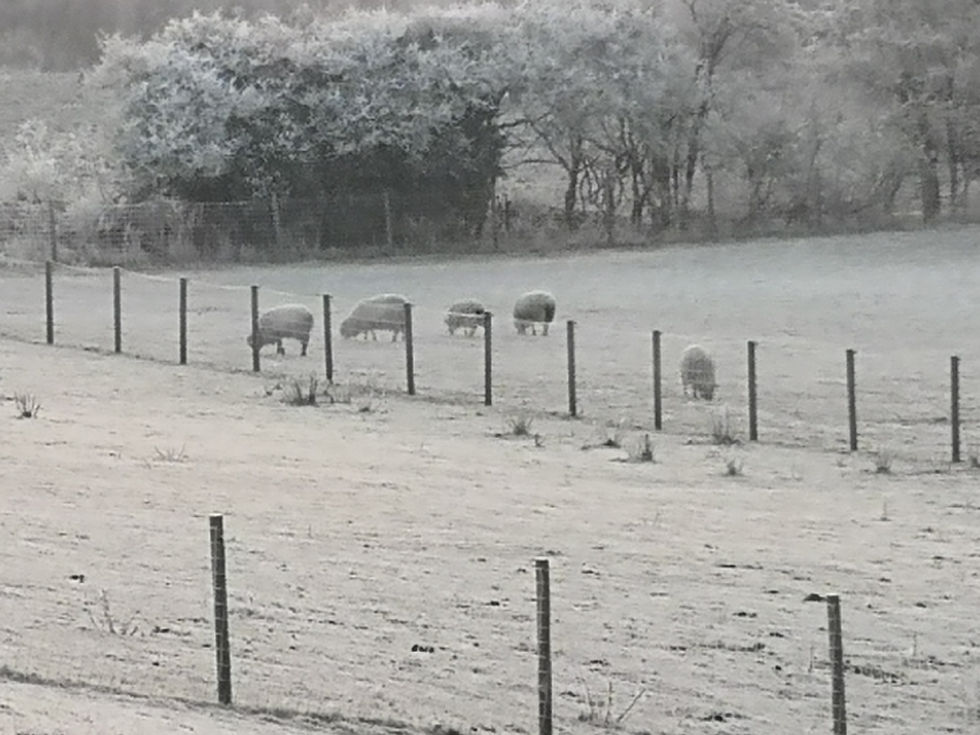Makeover time for our sheep
- Woolplay blog
- May 30
- 3 min read
This is shearing time of year for sheep farmers. And relief time for the sheep especially with the warm weather we've been having. And the start of the wool processing time of year for Woolplay.

Like most small sheep farmers we rely on a professional shearer coming out to our flock. It's skilled work to get a fleece off a sheep that's usable and very physical too. Our Leicester Longwool rare breed sheep weigh in excess of 150 pounds and our ram weighs closer to 250 pounds so tipping them over takes it out of you. They tipped to be sheared as sheep are more passive when they are on their backs, and it is easier to shear that way too.

Most sheep are pretty good about being sheared once they've been tipped. This year, half our sheep to be sheared were what's called shearlings. In other words, they are last year's lambs a have never been sheared before. Their fleeces are always sought after as they are the biggest the sheep will ever have (shearing is usually every 12 months and these are now 15 months old) and the best quality. Sheep fleeces deteriorate as the sheep get older - often not as thick and sometimes courser.
The fleeces are also affected by whether the sheep has lambed this year. One of our ewes last year had such a poor fleece after lambing that it wasn't worth sending off to be processed and instead was used for mulching the veg beds. This is why, after shearling fleeces, some of the best fleeces come from wethers (castrated male sheep) as they aren't subject to the same stresses and strains of breeding rams or ewes.
Most British sheep breeds need shearing once a year as over thousands of years we have bred them to have much thicker fleeces than the original wild sheep which would have shed their fleeces. For the month or so our sheep have been rubbing on hack racks and sheep pens but their fleeces are too thick to be dislodged.

We also shear our sheep as part of managing the risk of fly strike which is when flies lay eggs on the fleece, often near the back end and then the resulting maggots can burrow into the skin. Sheep can die if it's not treated. Shorn sheep are much easier to keep an eye on. One of our ewe's got fly strike with the first of the hot weather at the end of April. We had to cut away all her fleece from the affected area, remove the maggots which fortunately were only small and then treat her with maggot killer and oil.
I know I'm biased but Leicester Longwool fleeces are fabulous. Leicester Longwool is one of the classic "lustre longwool" breeds, renowned for the natural sheen and brilliance of its fleece. This lustre is especially noticeable just after shearing, when the wool shines in the sunlight and when it's been processed into tops or yarn. It's the staple (lock) length that is impressive, typically ranging from 200–250 mm (8–10 inches) and sometimes up to 14 inches in the shearling fleeces. The locks are spiral-tipped, well-defined, and hang individually, which prevents felting and makes the fleece easy to process.

As you can see from the photo, the fleeces are dense and heavy, with annual weights commonly between 3 and 5 kg). The wool is soft-handling and silky, with a medium crimp or wave from skin to tip. The combination of density, softness, and silkiness makes it highly desirable for handspinners and textile artists. Leicester Longwool fleece is extremely versatile and is suitable for a wide range of uses, from spinning fine lace-weight yarns to weaving, felting, and making durable textiles like rugs and homewares. The wool takes dye exceptionally well, including natural dyes and the natural lustre gives a brilliance to the dyeing.
Woolplay stocks Double Knit and Aran weight yarn made from our black faced and white faced Leicester Longwools. We also have silver and creamy white tops for spinners. Each year I keep back some of the fleeces to process myself. This allows me to retain the locks and hand dye them for my own weaving projects and to sell to fellow crafters.




Comments